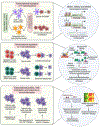Transcriptional determinants of cancer immunotherapy response and resistance
- PMID: 35125331
- PMCID: PMC9035058
- DOI: 10.1016/j.trecan.2022.01.008
Transcriptional determinants of cancer immunotherapy response and resistance
Abstract
The host immune response is a potent defense mechanism against cancer development and progression. To survive, cancer cells must develop mechanisms to evade the immune response. Based on this knowledge, a series of new therapies collectively referred to as immunotherapies have been developed and translated to the clinic for treating cancer patients. Although some cancer subtypes have shown strong clinical responses, including curative outcomes in some patients, immunotherapies have not worked as desired for some subtypes and forms of cancers. We provide an overview of the transcriptional mechanisms that drive the response and resistance to immunotherapies. We also discuss possible interventions to enhance the outcomes of immunotherapies by targeting dysregulated transcriptional networks in cancer cells.
Keywords: epigenetics; gene regulation; immunotherapy; transcription.
Copyright © 2022 Elsevier Inc. All rights reserved.
Conflict of interest statement
Declaration of interests A.M. has received research funding from Incyte, Takeda, Forty Seven Inc/Gilead, Juno Pharmaceuticals/Bristol Myers Squibb (BMS), Celgene/BMS, Innate Pharmaceuticals, Seattle Genetics, TG Therapeutics, Affimed, Merck, Kite/Gilead, Roche-Genentech, and I-MAB. A.M. has also served as a consultant, speaker, or on the advisory board of Gilead, Astra Zeneca, Pharmacyclics, Seattle Genetics, Incyte, Morphosys/Incyte, TG Therapeutics, Kyowa Kirin, Novartis, and BMS. R.G. and N.W. declare no conflicts of interest.
Figures



References
Publication types
MeSH terms
Grants and funding
LinkOut - more resources
Full Text Sources
Medical

